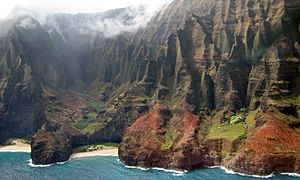Honopū Valley facts for kids
Honopū Valley is a special place located within the Nā Pali Coast State Park on the northwest shore of Kauaʻi, Hawaiʻi, in the United States. It's famous for its amazing natural arch, which is about 90 feet (27 meters) tall – making it the tallest natural arch in all of Hawaii! At the bottom of the valley, there's a hidden beach called Honopū Beach, also known as Cathedral Beach, which is about 0.25 miles (0.4 kilometers) long.
The name Honopū means "conch shell." The valley got its name because when strong winds blow from the north, the natural arch makes a sound like a conch shell.
Contents
Exploring Honopū Valley's Past
Honopū Valley and its beach are found on the beautiful Na Pali coast of Kauaʻi. This valley is very isolated, meaning it's hard to reach. You can't land any aircraft or boats directly in Honopū Valley or on its beach. So, if you want to visit, you usually have to swim from a boat offshore or from the nearby Kalalau Beach.
The "Lost Tribe" Legend
Because the valley is so hidden and mysterious, some people used to call it "the valley of the lost tribe." This legend came from a misunderstanding. In 1922, some archaeologists found old skulls there and thought they belonged to a very ancient, unknown group of people. However, later studies showed that everyone who lived there was actually Hawaiian. Even so, the interesting legend stuck around!
A Spiritual Place
Honopū Valley was, and still is, considered a very spiritual place by Hawaiians. It was home to temples and important burial grounds. Many Hawaiian legends and myths come from this valley. The cliffs around Honopū were used as a secret burial site for local chiefs. It was believed that a chief's bones held special power, and their location had to be kept secret to protect the tribe.
Nature's Bounty
The land in Honopū Valley is very fertile, meaning it's great for growing plants. If someone were ever stranded there, they could survive by eating the many wild fruits that grow along the coast, like guavas and grapefruit.
The Mysterious Menehune
The only information we have about the ancient and mythical Menehune people comes from stories told by native Hawaiians. Native Hawaiians call the Menehune "kamaʻaina," which means "children of the land." While they might just be characters from myths, it's said that the Menehune lived all over the Hawaiian Islands, especially on Kauaʻi, where there were many of them. Honopū Valley is sometimes called "the valley of the lost tribe" because it was believed to be the home of the last Menehune.
Visiting Honopū Valley
While you can't land directly in the valley, there are ways to see its beauty. You can hike along Honopū Ridge, which is above the cliffs. From there, you get amazing views of the ocean and Honopū Beach. Many tour boats travel along the coast, giving you a great view of the valley from the water. Helicopters also offer exciting aerial tours. The famous Kalalau Trail also ends close to Honopū Valley.
Honopū Valley in Movies
Honopū Valley is so beautiful and unique that it has been featured in many Hollywood films! In fact, aircraft and boats used for movie productions are the only ones allowed to land in Honopū Valley.
Filming King Kong (1976)
Honopū Valley is perhaps most famous for appearing in the 1976 remake of King Kong. The beaches and jungles of Kauaʻi were used to represent a fictional "Skull Island" in the South Pacific. The filmmakers loved Hawaii so much that they decided to shoot all the beach scenes at Honopū and Kalalau Valley.
A funny story from the filming of King Kong: the crew thought Honopū Valley was empty, but when they arrived to start filming, they were surprised to find honeymooners relaxing on the beach! Filming scenes in the ocean was also tricky because of the 12-foot-high waves. Many crew members got seasick, and one filming boat almost flipped over!
Other Famous Films
Honopū Beach was also a filming location for the movie Six Days Seven Nights. In this film, Hawaii stood in for French Polynesia. One exciting scene filmed on Honopū Beach shows Harrison Ford running from pirates. The famous natural arch is also shown in the movie.
Other Hollywood movies filmed in Honopū Valley include Honeymoon in Vegas, Acapulco Gold, and Raiders of the Lost Ark. More recently, the beach and surrounding scenery were used for the fourth Pirates of the Caribbean movie, On Stranger Tides (2011).



